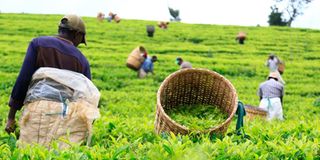Let’s improve productivity for higher incomes in agriculture, other sectors

Workers pick tea leaves at a farm in Nyeri town in this picture taken on February 8, 2021. An analysis of employment numbers of the Central Region Economic Bloc reveals agriculture as the bloc’s largest employer.
What you need to know:
- The Central Region Economic Bloc’s gross value added was 24.1 per cent of the national total in 2019.
- At Sh2.34 trillion, the bloc’s output was 25.2 per cent of the country’s gross value added in 2020.
- The region is a primary goods producer and consumer of goods manufactured outside the bloc, primarily from China and India.
In July last year, the Central Region Economic Bloc (Cereb) launched an initiative to promote a single market for businesses within the region by sharing data, removing the distribution charges and undertaking a joint investment promotion.
In furtherance of this objective, the Trade and Finance Committee has produced a new report on the size and structure of the region’s economy.
The report collates data from several research works and publications by the Kenya National Bureau of Statistics (KNBS).
It compiles the ‘gross value added’ (GVA) of tradeable goods and services to establish the value created in each county.
The bloc’s GVA was 24.1 per cent of the national total in 2019, only 0.8 per cent higher than in 2013.
The region’s value add to the national economy is slightly lower than Nairobi County’s contribution by 3.4 per cent.
At Sh2.34 trillion, the bloc’s output was 25.2 per cent of the country’s gross value added in 2020.
The gross value-added data reveals both the structural weaknesses and opportunities of the Cereb economy.
The region is a primary goods producer and consumer of goods manufactured outside the bloc, primarily from China and India.
This is probably the reason that the region, just like the whole country, is not creating sufficient and well-paying jobs for the youth and working population.
The market size, however, is sufficient to support domestic manufacturing.
An analysis of employment numbers reveals agriculture as the bloc’s largest employer. Of the bloc’s 4.7 million workers in 2020, 1.8 million (38 per cent) were employed in the agriculture sector.
The second largest sector with 1.2 million (26 per cent) workers was wholesale, retail and repair of motor vehicles. Manufacturing was third, employing 0.7 million workers, equivalent to 15 per cent of the workforce.
Value addition
All this points to the urgency required to re-engineer the bloc’s economy to raise productivity and value addition.
One possible solution is to increase the mechanisation of agriculture by producing the machines, tools and equipment necessary locally.
Turning to labour productivity measured by gross value added per worker for the top three employers, each agricultural worker added Sh481,000 annually.
The wholesale, retail trade and repair of motor vehicles worker generated Sh126,000, while a manufacturing worker generated Sh221,000 annually.
When computed on a monthly basis, wholesale, retail trade and repair of motor vehicle workers generated the lowest value at Sh11,000 monthly.
This publication is timely, coming as it has when governors are getting down to work after the 2022 elections.
In both the yellow and blue camps, the leading promises were about creating jobs and raising the earnings of the enterprises, farmers and workers.
Both will only be achieved if there are improvements in productivity. The latter demands that manufacturing and technology take centre stage.
@NdirituMuriithi is an economist.





